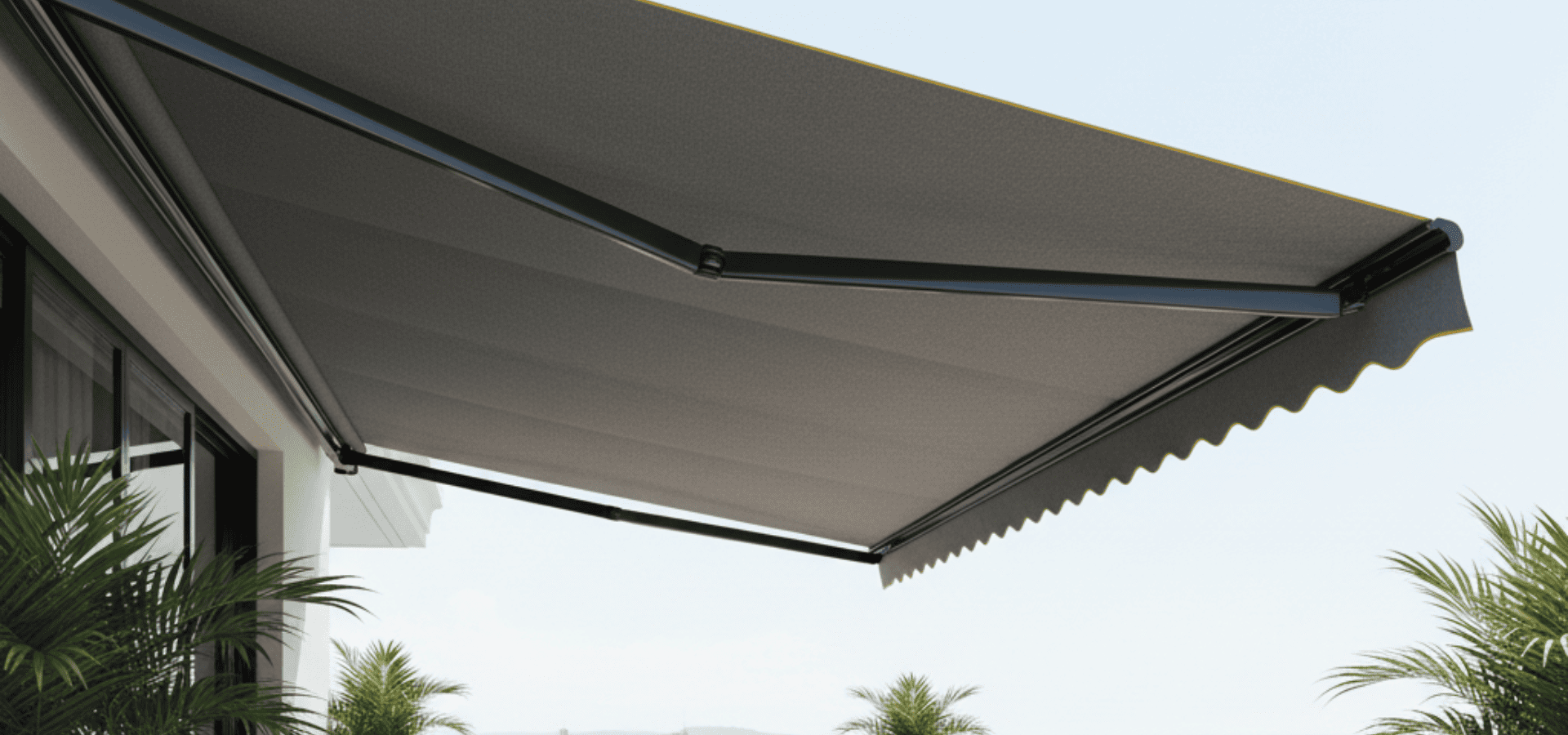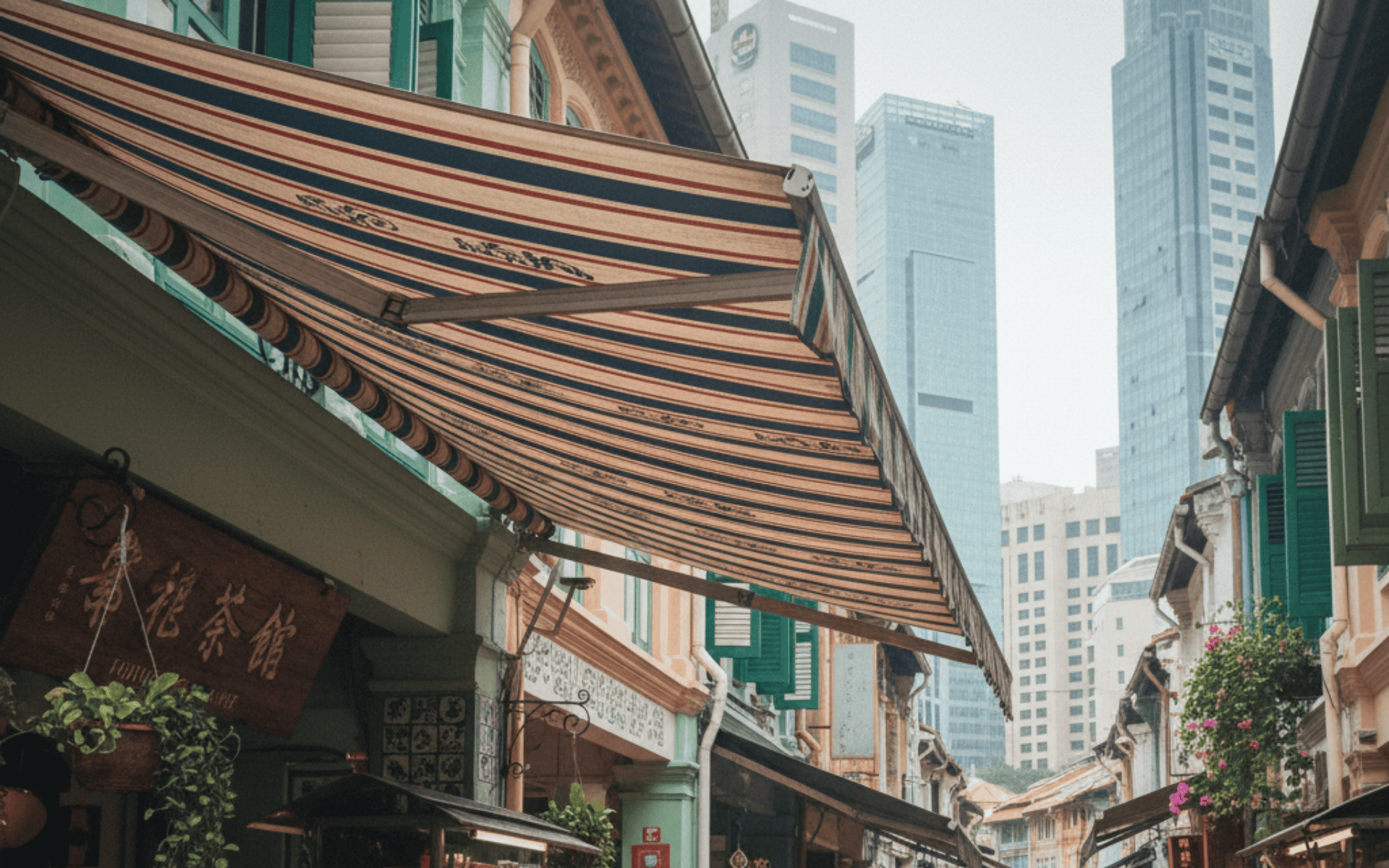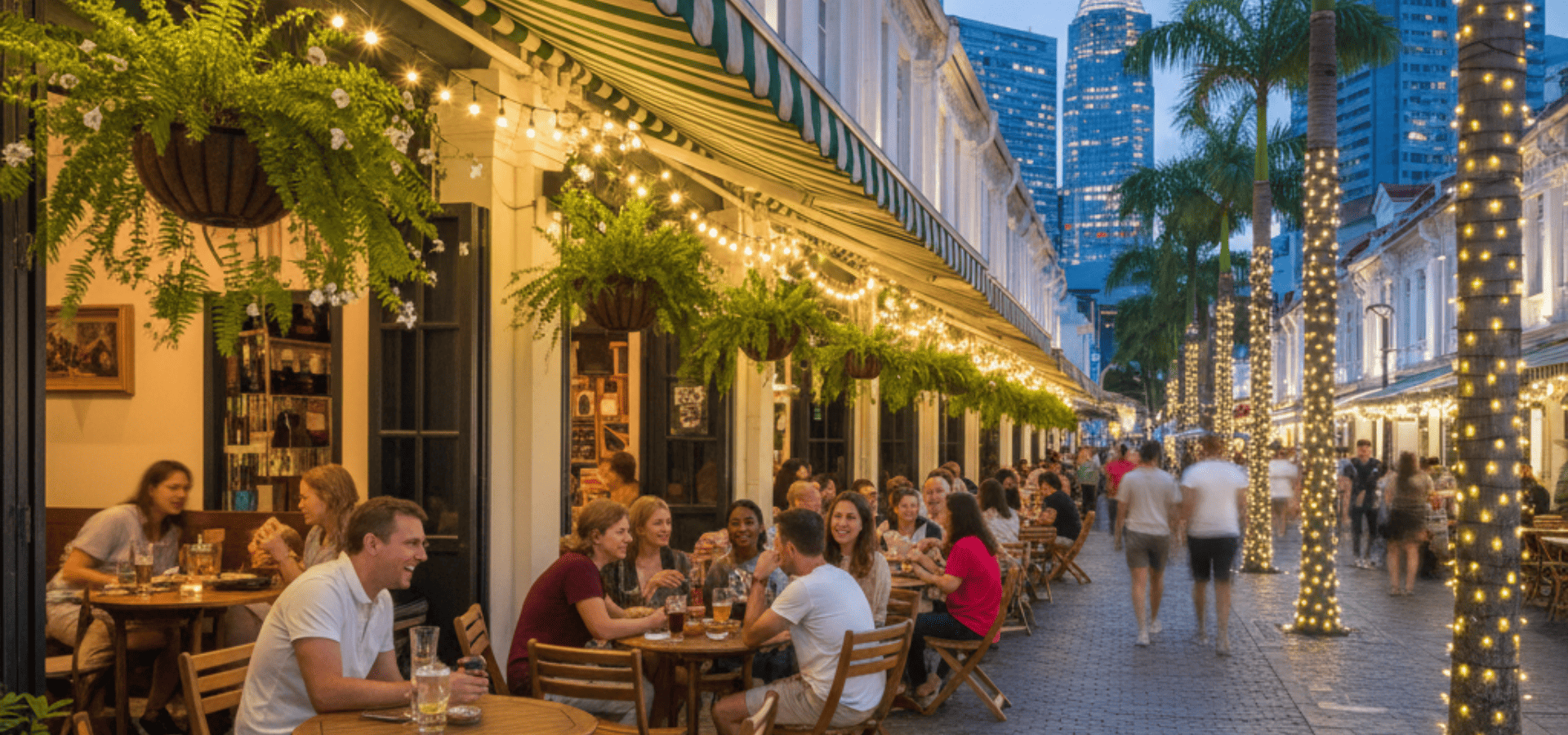Fire-Rated Awnings & Safety Certifications In Singapore
Singapore doesn’t play around when it comes to fire safety. And rightly so! We’re a dense, high-rise, urban island with tight neighbourhoods, bustling shophouses, and rooftop patios packed edge-to-edge.
There’s not a lot of room for error when something catches fire.
That’s why, if you're installing an awning — especially one attached to a commercial unit, an HDB flat, or a landed home near others — fire-rated materials and proper certifications aren’t just a box to tick. They’re part of keeping everyone safe, legal, and protected.
But let’s be honest. Between SCDF requirements, BCA codes, “Class 0” ratings, and suppliers promising the moon, it gets real confusing real fast. So we’re cutting through the noise.
Here’s what you actually need to know about fire-rated awnings in Singapore. What the certifications mean, when they apply, what kind of awning you need, and how not to get caught out by a dodgy spec sheet.
A little research now will avoid the hefty fine (or worse) later.
What Is A Fire-Rated Awning?
In plain terms. A fire-rated awning is one that’s made with materials tested to withstand or slow the spread of fire.
It doesn’t mean it’s fireproof (nothing truly is). It means the materials used — especially the fabric — have been certified to resist ignition, reduce flame spread, and minimise smoke production.
These ratings are particularly important for:
- Awnings on commercial properties (especially eateries or hawker stalls)
- Canopies near building exits or escape routes
- Installations on HDB blocks, especially common corridors
- Any place where cooking, smoking, or potential heat sources are nearby
And in a tightly packed urban space like Singapore, even a small flame can escalate quickly. Fire-rated fabrics give you that extra buffer. They’re designed not to add fuel to the fire… literally.
What Kind of Materials Make a Fire-Rated Awning “Fire-Rated”?
This is the bit most people miss — and where things can go sideways if you're not paying attention.
There’s a big difference between:
- A fabric that’s inherently fire-resistant (i.e., woven from fire-retardant fibres)
- A fabric that’s treated with a fire-retardant coating (which is often temporary)
- And a fabric that claims to be compliant but has no official test report
But overall, you can generally break it down into two categories:
- Inherent Fire-Resistant (FR) Fabrics
- Treated Fabrics
The former is your best-case scenario at a higher price. Inherent FR fabrics are usually made from fibres like modacrylic, glass fibre blends, or specially engineered polyesters. The resistance is built-in, not sprayed on, so they tend to last longer, perform better under heat, and resist washing out. Overall, while not your only option, they’re the best consistent bet for meeting any of Singapore’s codes for fire-rated awnings in commercial properties.
Meanwhile, treated fabrics are just standard materials (like PVC-coated polyester) that have been given a fire-retardant chemical coating. Provided you have a valid test report from an accredited lab, they can still be code-compliant in both residential and commercial settings. But while they are the cheaper solution, the coating generally degrades over time, especially in Singapore’s UV-heavy, humid climate.
If your awning gets a lot of exposure, or you’re using it near food stalls, grills, or communal areas, it’s a much better call in the long run to purchase a fire-rated awning with inherent FR fabric. Your neighbours will thank you.
Singapore’s Safety Framework: Who Regulates What
Before diving into the different types of ratings, it helps to know which authorities are involved with the regulatory framework:
- SCDF (Singapore Civil Defence Force): This body oversees fire safety regulations as well as issues any Fire Safety Certificates.
- BCA (Building and Construction Authority): This authority regulates building works, including awnings attached to structures.
- FSSD (Fire Safety & Shelter Department): This branch of the SCDF approves fire-rated materials for use.
Any awning used in a building that requires fire safety approval (i.e., most commercial or mixed-use structures) will need to comply with this trio of bodies. Which means a lot of documentation!
Decoding Fire Ratings: What Certifications Actually Mean
This is where things get messy. This is also where suppliers start tossing around terms without context.
Let’s break down the most common certifications and phrases you’ll see locally, so you can separate the fact from the fictitious leveraging of uninformed consumers.
Class 0 Surface Spread of Flame (UK Standard)
This is the benchmark many Singaporean authorities refer to — especially for external building elements.
A material rated Class 0 under the BS 476 Part 6 & 7 test means:
- It doesn’t ignite easily
- If it does catch fire, the flame doesn’t spread quickly
- It doesn’t produce lots of smoke or dripping embers
This is what you want for fabrics used on or near buildings, particularly anything overhead like an awning.
EN 13501-1 (European Standard)
This is a more modern, widely recognised European classification. It breaks down fire performance into:
- A1–F: From non-combustible (A1) to highly combustible (F)
- s1–s3: Smoke production (s1 = low smoke)
- d0–d2: Flaming droplets (d0 = none)
For example, a B-s1,d0-rated fabric would be a solid choice. It’s strongly non-combustible (B-rating), barely smokes when on fire (s1), and doesn’t drip flames and embers. For reference, a lot of premium acrylics and polyester canvas fall in this range.
ASTM E84 / NFPA 701 (US Standards)
You’ll also see these mentioned by international suppliers:
- NFPA 701: This rating measures flame propagation in textiles. Many commercial-grade fabrics used in awnings and tents aim for this.
- ASTM E84: And this rating is more for interior surfaces, but some outdoor-use products are dual-tested.
These are the US standard, and you’ll see them a lot on imported awning products. That’s why it’s crucial to understand them.
However, Singapore actually employs the equivalent standards of BS 476 (British Standard) or SS 476 (Singapore Standard). It’s crucial to note that the SCDF nearly always requires materials to meet the local SS 476 Class 0 classification (based on BS 476 Parts 6 and 7) unless equivalency has been proven on imported products.
So if you see NFPA 701 or ASTM E84 on an imported product, it almost definitely is well-equipped for fire scenarios. However, you will need a valid test report from an accredited lab to prove its compliance with local standards.
When Do You Actually Need A Fire-Rated Awning In Singapore?
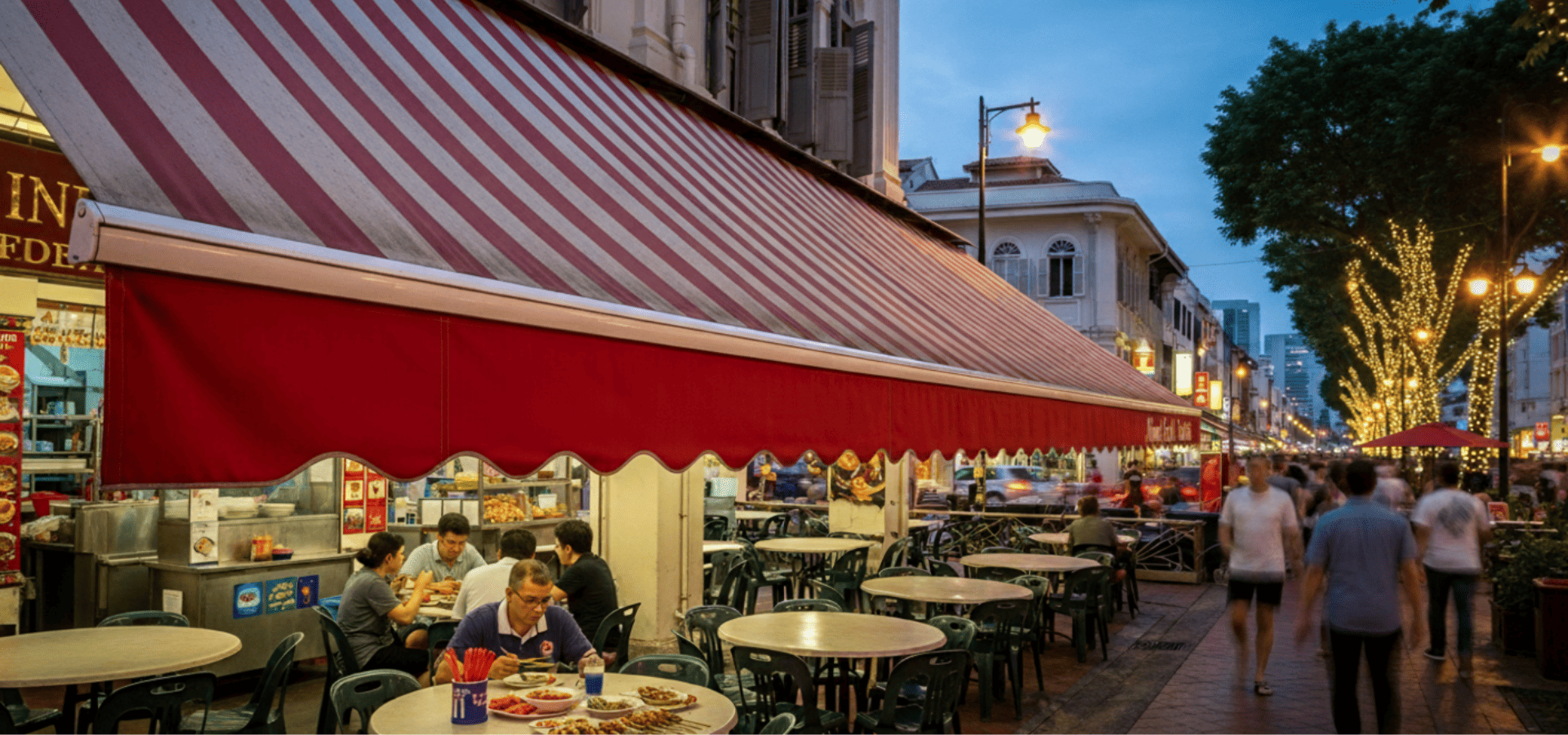
Here’s where most homeowners and businesses get stuck. The truth is that not all awnings need to be fire-rated. But if yours does, it’s a legal requirement, not a nice-to-have.
Let’s break it down by context.
Fire-Rated Awning Required (Legally Mandated)
These are the situations where you’re nearly always going to be required to install a fire-rated awning:
- HDB corridors and public walkways: Any fixed shading device added to an HDB common area must comply with SCDF standards. Fire-retardant materials are often a condition for approval in these situations.
- Commercial units (esp. F&B): If you’re a café, stall, or restaurant with external shading or al fresco seating, SCDF is likely to require fire-rated fabrics.
- Canopies over escape routes: If your awning shades a fire escape path or exit, it must be made from certified non-combustible or fire-retardant materials.
Fire-Rated Awning Strongly Recommended (But Not Enforced)
These are scenarios where you can skip the fire-rated awning installation, however, we’d still really recommend one for safety:
- Landed property patios: Technically, if it’s within your own plot and doesn’t obstruct exits, your awning may not need certification. However, it's still smart to go FR, especially if you're using BBQs or heaters.
- Condo balconies or roof terraces: Strata rules may vary in these scenarios, but going fire-rated reduces liability, especially in shared spaces.
Fire-Rated Awning Not Necessary (Unless You Really Want One)
And in these situations, a fire-treated awning is, to be honest, pretty overkill:
- Indoor awnings or blinds: Anything fully inside a private, air-conditioned space is generally outside the SCDF’s scope, unless you’re in a high-hazard occupancy like a commercial kitchen.
- Garden pergolas far from structures: If it’s freestanding, well clear of any building, and not over a designated escape path, there’s usually no regulatory trigger for FR materials.
- Small shade sails in private yards: For purely decorative or light shade purposes in non-shared spaces, fire-rating is a nice-to-have rather than a need-to-have.
- Temporary party/event tents at home: If they’re on private property and not over public walkways or exits, they won’t attract SCDF enforcement (though some event suppliers will upsell).
What To Ask Your Awning Contractor (Before You Sign Anything)
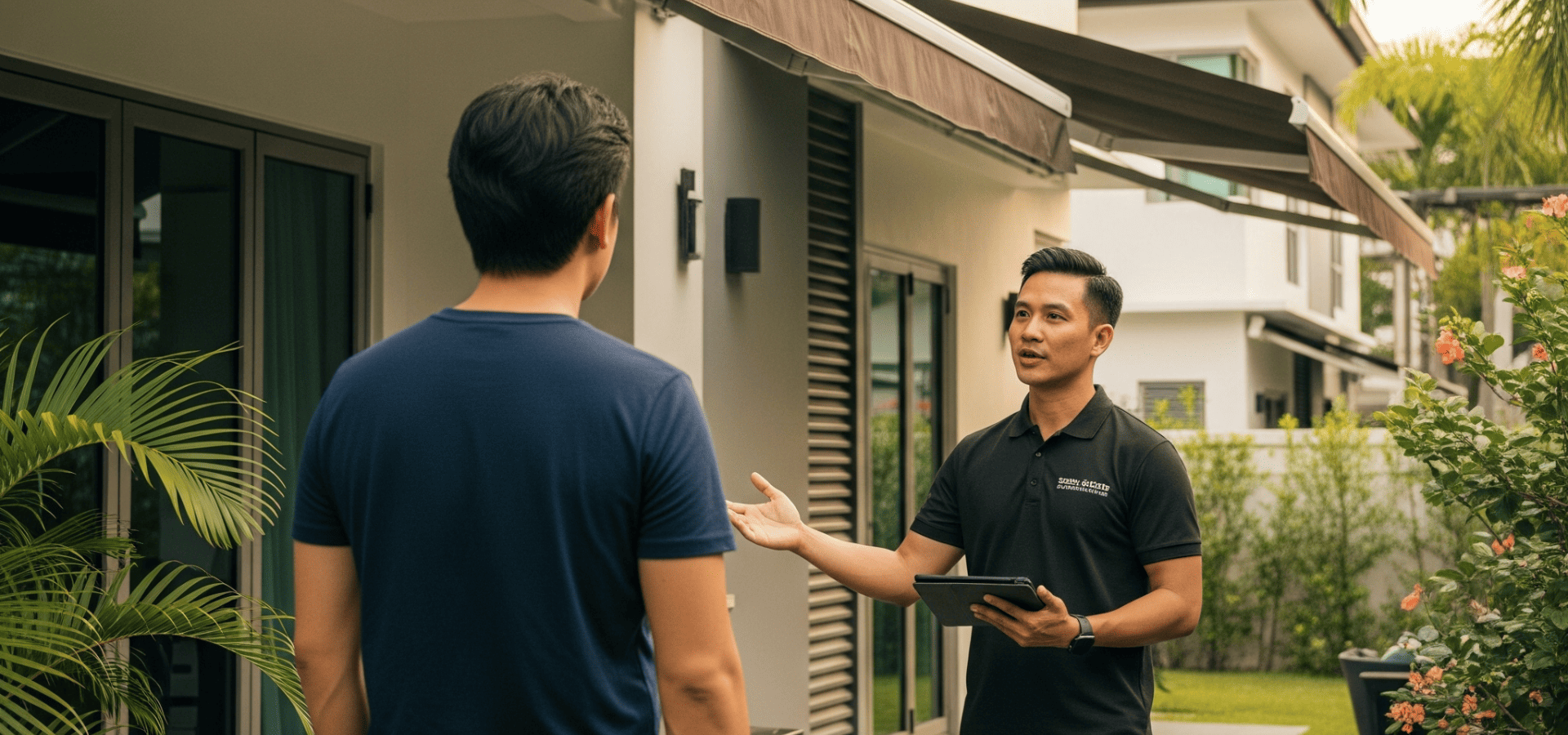
Suppliers love to say “fire-rated”. But unless you ask the right questions, you might end up with vague claims and zero documentation.
Here’s what to press any awning contractor you’re with for more information on:
- What’s the exact fire rating of the fabric? (Get the standard: BS 476, EN 13501, etc.)
- Is the fire retardancy inherent or applied?
- Do you have a valid test report from an accredited lab?
- Has this product been approved for use in Singapore by the FSSD or SCDF?
- Is it suitable for use in [your specific property type]?
You’re not being fussy; you’re protecting your safety, your compliance, and your wallet. If a fire ever breaks out and you’ve installed a non-compliant awning, insurance claims get very messy overnight.
Wrapping Up: Other Safety Considerations And Compliance
While we’re on the subject, fire isn’t the only safety concern with awnings. Singapore’s weather has its own checklist of moody Mondays and terrible tirades:
- Wind resistance: Make sure the frame is rated for sudden gusts, look for European Wind Class ratings if available.
- Drainage: In the monsoon season, pooling rainwater can stretch or collapse cheap awnings.
- UV protection: Fire-resistant doesn’t always mean UV-resistant, and the UV will wear down treated fire-rated materials too. Try to get both.
Compliance is one part of the game. The other part is making sure your whole awning functions as a cohesive and safe unit built to last.
It doesn’t have to be ugly or basic, either. Plenty of modern awnings in Singapore tick all the safety boxes and look sharp doing it. You’ve got options in colour, pattern, texture, and even smart automation, all without compromising on safety.
The most vital thing is that you don’t make the mistake of assuming “looks sturdy” for “is compliant.” Fire safety is invisible: it lives in test certificates, material specs, and approval papers.
So if you’re adding or upgrading an awning in Singapore, especially on a commercial property or shared space, treat fire-rated certification as a must-have, with all the due diligence that requires. You’ll sleep better knowing your shade won’t turn into a fire accelerant.
And in a country where you’re never more than five metres from the next flat, neighbour, or noodle stall, that’s a comfort worth paying for.
